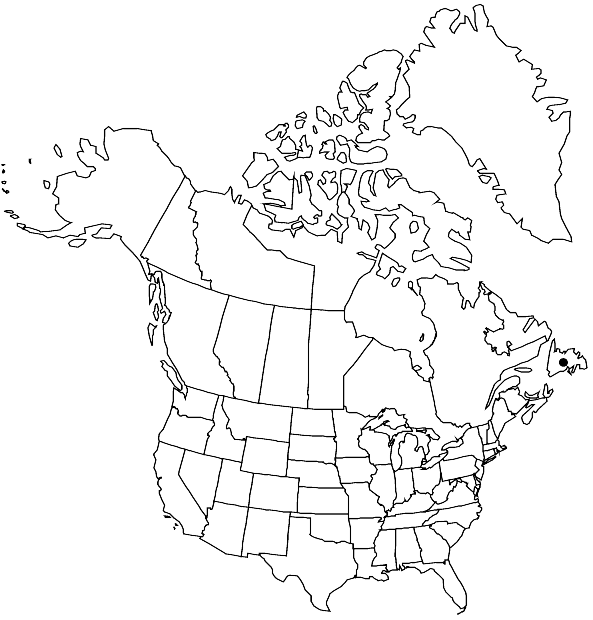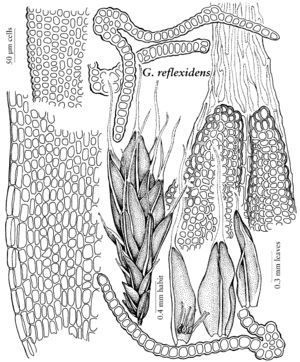Grimmia reflexidens
Syn. Musc. Frond. 1: 795. 1849,.
Plants in compact hairy cushions, grayish green. Stems 1–2 cm, central strand absent. Leaves ovate to oblong-lanceolate, 0.1–1.15 × 0.3–0.5 mm, keeled, not plicate, margins plane, awns 1–2 mm, very long, smooth to slightly denticulate, flattened basally, long-decurrent, costal transverse-section prominent, semicircular; basal juxtacostal laminal cells rectangular, sometimes nodulose, thin to thick-walled; basal marginal laminal cells rectangular with thickened transverse walls, pellucid in 2–4 rows; medial laminal cells roundedquadrate, slightly sinuose, thick-walled; distal laminal cells yellowish green, 1-stratose with 2-stratose ridges, not bulging, marginal cells 2-stratose, not bulging. Sexual condition dioicous, perichaetial leaves enlarged. [Seta straight, 1.5–2 mm. Capsule absent in northern hemisphere material, emergent to shortly exserted, yellowish brown, oblate, exothecial cells irregularly short-rectangular, thin-walled, stomata absent, annulus of 1 row of quadrate, thick-walled cells, operculum mammillate to rostrate, peristome present, nearly fully-developed, split and perforated only in apex, papillose.]
Habitat: Dry acidic rock
Elevation: low [to moderate] elevations (50[-300] m)
Distribution

Nfld. and Labr. (Nfld.), South America (Argentina), South America (Chile), Atlantic Islands (Iceland), Pacific Islands (New Zealand), Australia
Discussion
Of conservation concern.
Previous to its discovery in Iceland, as Grimmia grisea (H. C. Greven 1998), G. reflexidens was known from only the Southern Hemisphere. It had previously been collected east of East Bay, Newfoundland, now the only known locality in North America, but was not recognized as G. reflexidens. The latter is similar to G. asperitricha Dixon & Sainsbury of New Zealand, and the two species have been confused by G. O. K. Sainsbury (1945) as well as by R. Ochyra (1993). J. Muñoz (1998b) synonymized G. reflexidens with G. sessitana. However, the former is readily separated from the latter by: (1) enlarged perichaetial leaves, (2) decurrent awns, (3) non-bulging laminal cells, and (4) dioicous sexual condition. Capsules are unknown from Northern Hemisphere material, but G. reflexidens lacks stomata while they are present for G. sessitana. Although G. reflexidens and G. teretinervis both have decurrent awns they are easily separated by a number of characters: G. reflexidens grows in compact cushions, has long awns, and a semicircular costa; G. teretinervis grows in loose clumps, is hyaline-tipped to short-awned, and has a unique costa that is distally almost completely circular in transverse section.
Selected References
None.
